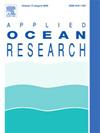用于单桩海上风力涡轮机气液伺服弹性评估的实时混合模型槽测试
IF 4.3
2区 工程技术
Q1 ENGINEERING, OCEAN
引用次数: 0
摘要
物理模型尺度测试有助于确定重要的耦合效应和验证数值模拟。然而,由于缩放效应,海上风力涡轮机模型的动态相似性要求很难满足。为了应对这一挑战,我们提出了一种测试方法,使用线性致动器再现实时混合模型测试所需的空气动力。使用基于空气动力耦合分析开发的数值子结构对施加力的大小进行了模拟。本文设计了海上风力涡轮机的物理子结构,选择了 "硬件在环 "方法,并在波浪槽中进行了相关实验。试验过程中再现了湍流风和变桨控制。对实验数据和模拟结果进行了对比和分析。不同物理量(转子推力、塔顶位移)测量平均值的最大误差为 5.51%,而标准值的最大误差为 -10.59%。这些数据表明实验结果与模拟结果之间具有良好的一致性。通过分析不同物理量的功率谱密度 (PSD) 结果发现,湍流风在低于波浪激励的频率范围内提供了显著的激励和能量。湍流风载荷的频率掩盖了低频二阶波力,这表明在实验中再现湍流风的必要性。实时混合模型试验方法可精确再现湍流风载荷,实现随机风和波浪的联合作用,提高现有单桩海上风电机组的模型试验水平。本文章由计算机程序翻译,如有差异,请以英文原文为准。
Real-time hybrid model tank testing for aero-hydro-servo-elastic assessment of a monopile offshore wind turbine
Physical model-scale testing could assist in identifying important coupling effects and validating numerical simulations. However, the requirement regarding the dynamic similarity for the offshore wind turbine model is difficult to meet due to the scaling effects. To address this challenge, a testing method is proposed, using a linear actuator to reproduce the required aerodynamic force for the real-time hybrid model test. The magnitudes of the applied force were simulated using a numerical substructure developed based on the aerodynamic coupling analysis. This paper designed the physical substructure of offshore wind turbines, selected the "Hardware in the Loop" method, and conducted relevant experiments in a wave tank. The turbulent wind and pitch control were reproduced during the testing process. The experimental data and simulation results were compared and analyzed. The maximum error of the average values of different physical quantities (Rotor thrust force, Tower top displacement) measured was 5.51 %, while the maximum error in the standard values was −10.59 %. The data indicate good consistency between the experimental and simulation results. From the analysis of power spectral density (PSD) results of different physical quantities, it was found that turbulent wind provides significant excitation and energy in the frequency range below wave excitation. The frequency of turbulent wind loads hides the low-frequency second-order wave forces, indicating the necessity of reproducing turbulent winds in experiments. The real-time hybrid model test method can accurately reproduce the turbulent wind load, achieve the combined action of random wind and waves, and improve the model testing level of existing monopile offshore wind turbines.
求助全文
通过发布文献求助,成功后即可免费获取论文全文。
去求助
来源期刊

Applied Ocean Research
地学-工程:大洋
CiteScore
8.70
自引率
7.00%
发文量
316
审稿时长
59 days
期刊介绍:
The aim of Applied Ocean Research is to encourage the submission of papers that advance the state of knowledge in a range of topics relevant to ocean engineering.
 求助内容:
求助内容: 应助结果提醒方式:
应助结果提醒方式:


